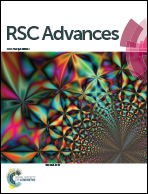Rationally designed hierarchical MnO2@NiO nanostructures for improved lithium ion storage†
Abstract
The design of hierarchical nanostructures to be used as anodes (involving higher rate capabilities and better cycle lives) and meet further lithium ion battery applications has attracted wide attention. Herein, a hierarchical MnO2@NiO core–shell nanostructure with a MnO2 nanorod as the core and NiO flakes as the shell has been synthesized by combining a hydrothermal treatment and an annealing process. MnO2 nanorods serve as a high theoretical capacity (1233 mA h g−1) material, and they allow efficient electrical and ionic transport owing to their one-dimensional structure. The porous NiO flakes used as the shell would enlarge the contact area across the electrode/electrolyte, and can also serve as volume spacers between neighboring MnO2 nanorods to maintain electrolyte penetration as well as reducing the aggregation during Li+ insertion/extraction. As a result, the MnO2@NiO core–shell structure exhibits improved cycling stability (939 mA h g−1 after 200 cycles at a current density of 1 A g−1) and outstanding rate performance, suggesting that the synergetic effect and characteristics of the core–shell nanostructure would benefit the electrochemical performance of lithium ion batteries.


 Please wait while we load your content...
Please wait while we load your content...